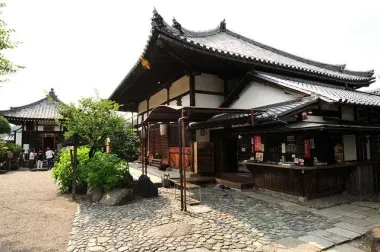Buddhism: a religion in Japan 仏教
The 6 Schools of Japanese Buddhism
Religion in Japan is often the subject of curiosity about other cultures, due to the peaceful coexistence of Shintoism and Buddhism within Japanese society. Today, approximately 75% of the population observe Buddhist practices and 90% say they also practice Shintoism, which amounts to saying that the vast majority practices two religions at the same time...
Buddhism is therefore one of the two main religions in Japan. It would have been introduced in the archipelago from the 5th century AD. It has developed considerably over the centuries until it has become a major part of Japanese society. Today, it coexists with Shintoism, an animist religion, comprised of different schools born of various eventss over time.
The beginnings of Buddhism in Japan
Buddhism was introduced to Japan by China, through contacts between the various territories of the Far East under the effect of the Silk Road. However, its official introduction is dated 552 AD. AD, when King Seong of Baekje (now South Korea) sent Buddhist missionaries carrying a Buddha image and sutras to Emperor Kinmei to introduce Buddhism.
- Read also: History of Japan, simplified chronology
In less than two centuries, under the Asuka and Nara eras, Buddhism then developed considerably, in particular, thanks to its adoption by powerful clans: in 627, there were already nearly 50 Buddhist temples in Japan as well more than 800 monks and 700 nuns. Already in the Nara period (710-794), six different schools of Buddhism had been founded in Japan: more than distinct religious currents, they could be identified as different groups of thought, settled in different temples. It was at this time that the great Asuka-dera and Todai-ji temples were erected in Nara.
At that time, the Buddhist temples were precisely places of instruction and education, strictly speaking, schools of scholars, much more powerful than today. The religion they taught then was a mixture of Buddhist, Taoist practices, with shamanic and indigenous elements. At the end of the Nara era, two new schools were born in Japan, associated with esoteric Buddhism: Shingon and Tendai, introduced respectively by the monks Kûkai (better known under the name of Kôbô Daishi) and Saichô. If the fundamental schools of Nara have disappeared today to give way to other developments of Buddhist thought, these two schools of esoteric Buddhism have survived until our time.
- To read also: Aoba matsuri, a festival to the glory of Kûkai

The Golden Temple or Kinkakuji, one of the jewels of Kyoto.
GL
The 6 schools of Japanese Buddhism today
Japanese Buddhism has undergone many changes since the Nara era and the 6 schools that originally existed have now disappeared. By chance, the schools that still exist today are also 6 in number. It was during the Kamakura era (1185-1333) that the other schools of Buddhism that still exist today developed. Here is the list, with their main characteristics:
- Tendai: founded in 822 by Saicho, it is the oldest school that persists today, and the most widespread. This branch of Buddhism reveres the Lotus Sutra and differs from its Chinese equivalent (Tien Tai) in its mysticism and esoteric aspects.
- Shingon: founded by the monk Kukai in 835, this school is a rival of the previous one. The system of Shingon Buddhism is tantric. He teaches that through the repetition of mantras, meditation, and ritual gestures, one can access the power of Buddhas and bodhisattvas.
- Jōdo, the "Pure Land" school: this school reveres the Pure Land sutra and advocates devotion to Amida Buddha. Only by these means can one attain rebirth within the Pure Land, that is, the paradise where this Buddha resides. This school has become one of the most widespread forms of Buddhism in Japan.
- Jōdo-Shinshū, or the True Pure Land school: this sect goes further than the previous one, and teaches that humility and faith, in the love of Amida Buddha, are already present in the hearts of believers. Amida saves souls without prerequisites. That is to say, faith and good deeds performed come spontaneously from Amida Buddha, who needs no other proof to grant salvation.
- Nichiren: Named after its founder, this school reveres the Lotus Sutra and teaches that the mere repetition of this sutra is enough to attain paradise.
- Zen: Zen has different schools itself, but traditionally it is associated with the Rinzai sect, promoted by Eisai. She draws on the authority of traditional Buddhist scriptures and the repetition of the koan, a form of a meditative phrase, as a way to transcend earthly linear thought. The Soto sect also upholds the authority and validity of the scriptures but relies only on silent meditation, not the koan.













